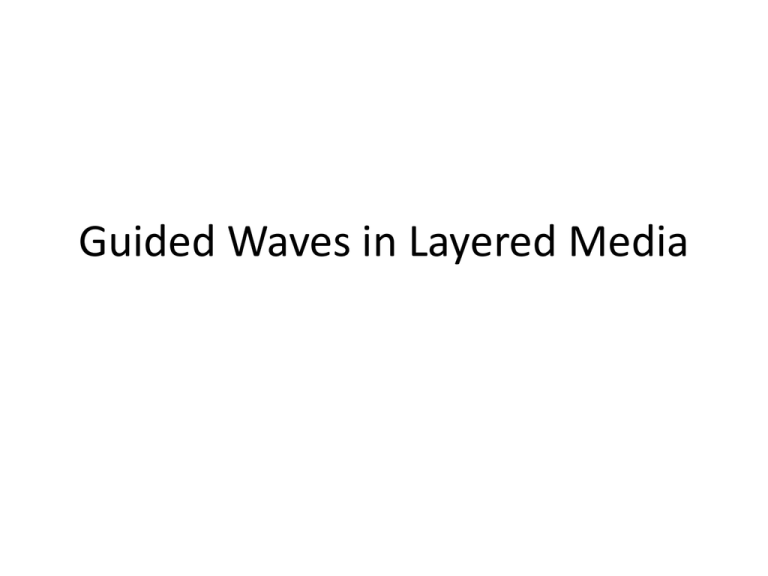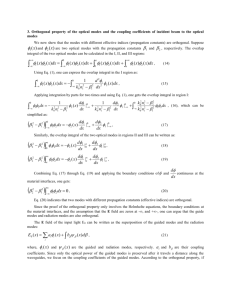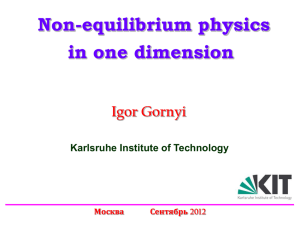Guided Waves in Layered Media
advertisement

Guided Waves in Layered Media Guided Waves in Layered Media Layered media can support confined electromagnetic propagation. These modes of propagation are the so-called guided waves, and the structures that support guided waves are called waveguides. Symmetric Slab Waveguides • Dielectric slabs are the simplest optical waveguides. • It consists of a thin dielectric layer sandwiched between two semi-infinite bounding media. • The index of refraction of the guiding layer must be greater than those of the surround media. Symmetric Slab Waveguides • The following equation describes the index profile of a symmetric dielectric waveguide: Symmetric Slab Waveguides • The propagation of monochromatic radiation along the z axis. Maxwell’s equation can be written in the form Symmetric Slab Waveguides • For layered dielectric structures that consist of homogeneous and isotropic materials, the wave equation is • The subscript m is the mode number Symmetric Slab Waveguides • For confined modes, the field amplitude must fall off exponentially outside the waveguide. • Consequently, the quantity (nω/c)^2-β^2 must be negative for |x| > d/2. Symmetric Slab Waveguides • For confined modes, the field amplitude must fall off sinusoidally inside the waveguide. • Consequently, the quantity (nω/c)^2-β^2 must be positive for |x| < d/2. Guided TE Modes • The electric field amplitude of the guided TE modes can be written in the form Guided TE Modes • The mode function is taken as Guided TE Modes • The solutions of TE modes may be divided into two classes: for the first class and for the second class • The solution in the first class have symmetric wavefunctions, whereas those of the second class have antisymmetric wavefunctions. Guided TE Modes • The propagation constants of the TE modes can be found from a numerical or graphical solution. Guided TE Modes Guided TM Modes • The field amplitudes are written Guided TM Modes • The wavefunction H(x) is Guided TM Modes • The continuity of Hy and Ez at the two (x=±(1/2)d) interface leads to the eigenvalue equation Asymmetric Slab Waveguides • The index profile of a asymmetric slab waveguides is as follows • n2 is greater than n1 and n3, assuming n1<n3<n2 Asymmetric Slab Waveguides Typical field distributions corresponding to different values of β Guided TE Modes • The field component Ey of the TE mode can be written as • The function Em(x) assumes the following forms in each of the three regions Guided TE Modes • By imposing the continuity requirements , we get • or Guided TE Modes • The normalization condition is given by • Or equivalently, Guided TM Modes • The field components are Guided TM Modes • The wavefunction is Guided TM Modes Guided TM Modes • We define the parameter • At long wavelengths, such that No confined mode exists in the waveguide. Guided TM Modes • As the wavelength decreases such that One solution exists to the mode condition Guided TM Modes • As the wavelength decreases further such that Two solutions exist to the mode condition Guided TM Modes • The mth satifies Surface Plasmons • Confined propagation of electromagnetic radiation can also exist at the interface between two semiinfinite dielectric homogeneous media. • Such electromagnetic surface waves can exist at the interface between two media, provided the dielectric constants of the media are opposite in sign. • Only a single TM mode exist at a given frequency. Surface Plasmons • A typical example is the interface between air and silver where n1^2 = 1 and n3^2 = -16.40i0.54 at λ = 6328(艾). Surface Plasmons • For TE modes, by putting t=0 in Eq.(11.2-5), we obtain the mode condition for the TE surface waves, p + q =0 Where p and q are the exponential attenuation constants in media 3 and 1. • It can never be satisfied since a confined mode requires p>0 and q>0. Surface Plasmons • For TM waves, the mode funcion Hy(x) can be written as • The mode condition can be obtained by insisting on the continuity of Ez at the interface x = 0 of from Eq.(11.2-11) Surface Plasmons • The propagation constant β is given by • A confined propagation mode must have a real propagation constant, since <0, Surface Plasmons • The attenuation constants p and q are given Surface Plasmons • The electric field components are given Surface Plasmons • Surface wave propagation at the interface between a metal and a dielectric medium suffers ohmic losses. The propagation therefore attenuates in the z direction. This corresponding to a complex propagation constants β • Where α is the power attenuation coefficient. Surface Plasmons • In the case of a dielectric-metal interface, is a real positive number and is a complex number (n – iκ)^2, and the propagation constant of the surface wave is given Surface Plasmons • In terms of the dielectric constants • The propagation and attenuation constants can be written as Surface Plasmons • The attenuation coefficient can also be obtained from the ohmic loss calculation and can be written as • σ is the conductivity









